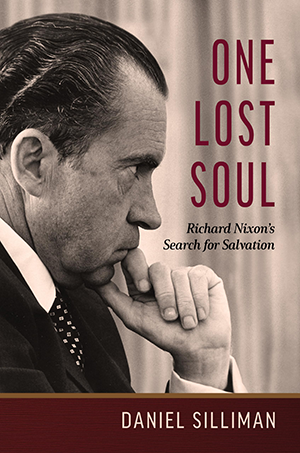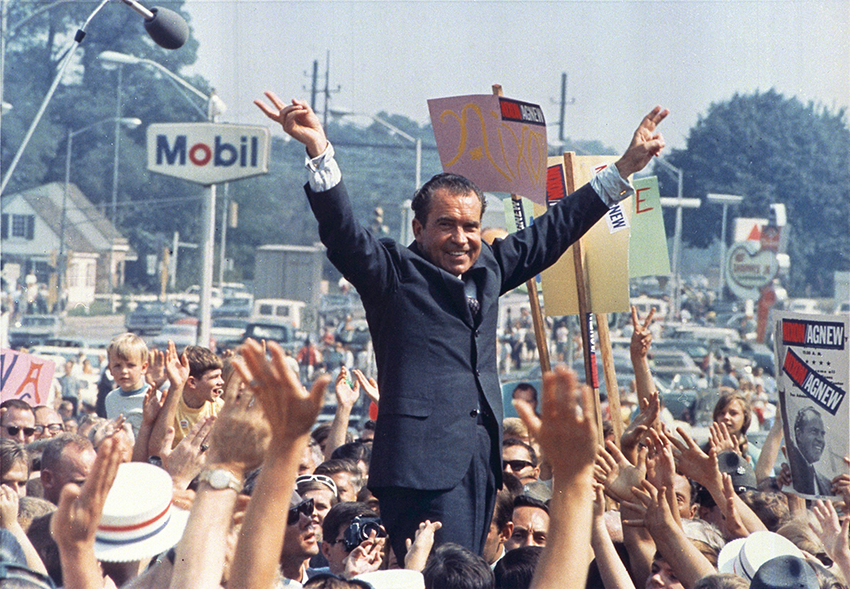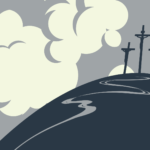Review: One Lost Soul: Richard Nixon’s Search for Salvation, Daniel Silliman, Eerdmans
There are many books about Richard Nixon, largely because of the Watergate saga, and also because his intriguing personality is like something out of a Shakespearean drama. He was a victim of warring sides of his personality – paranoia and an urge to live up to noble ideas. (In Protestant terminology he was a mix of saint and sinner, or perhaps with a devil and an angel on each shoulder whispering incessantly in his ears.) He dismissed analysis by biographers but is probably the most analysed US president since Lincoln. Even so, his religious beliefs have been somewhat neglected, apart from the basics.
Daniel Silliman sees Nixon’s religious beliefs adding to the tragic aspects of his character. Nixon was a man who wanted to be loved and redeemed but saw no way other than to work hard at beating his enemies, a kind of works righteousness, in this biographer’s eyes.

Nixon prided himself in being a fighter, and there were aspects of his character that were persistent, but he was also thin-skinned, bitter, petty and perpetually slighted. Even when at fault, he would turn every crisis into a picture of him being the embattled underdog. At the height of the Watergate crisis, just before his resignation, he called his security advisor, Henry Kissinger, up to the White House residence where a tearful Nixon asked Kissinger to pray with him. Kissinger, recounting the incident later, said, ‘Imagine what this man would have been had somebody loved him.’ Silliman’s argument is that somebody (up there) did, but Nixon couldn’t accept it.
It seems appropriate that Nixon’s father bought an old wooden church to turn into a grocery store, considering the Nixons’ emphasis on redemption through hard work. Nixon felt he never measured up in his parents’ eyes, and his answer was to work and then work some more. (As president he would ask his aides to fudge his schedule so it looked like he was working longer hours than he was.) He grew up in a Quaker church, but the Quakers of Whittier, different to some of their counterparts, preached that the ethical life involved constant striving, rather than the injection of grace, and in this, says Silliman, they looked and sounded as much Calvinist as Quaker.
Nixon seems to have been influenced by his Quaker upbringing to the extent that he felt the highest calling for a leader was to be a peacemaker, but he differed from traditional Quakers in holding the potentially paradoxical yet Realpolitik idea that peace is achieved through war. (With Vietnam, this policy would end up being ineffectual.) He had his doubts about the Quakers – they were not assertive and American enough. The pacifist Quakers, in turn, wanted to disown him for his escalation of the Vietnam War.
At university, Nixon decided his faith was less fundamentalist and more deist (though in typical Nixon fashion he was fighting partly imaginary foes – the Quakers weren’t really fundamentalist). Nixon indicated Jesus was simply a figure to emulate with hard work. Later, while living in New York and working as a lawyer, he was attracted to the church of Norman Vincent Peale, with its very American, can-do attitude.
Nixon was a friend of Billy Graham, who was convinced Nixon was a moral light for the country, partly through his anticommunism, which Silliman describes as something like a religious conversion. Graham counselled Nixon in how to be more of a public Christian – displaying a sort of muscular Christianity with a moral crusading edge. But Nixon routinely ignored Graham’s encouragement, believing not only in the separation of church and state but also that faith was a private matter.
Nixon wasn’t much of a churchgoer. (It’s hard sometimes to know what Graham saw in him.) He didn’t understand evangelicals the way Carter and George W. Bush did. He was, unusually for a politician, wary of people observing him in public. So, he decided, against protocol, that he would have semi-regular church services in the White House. This is one of the most fascinating aspects of this book, something not discussed at length elsewhere, as far as I am aware.
By having services in the White House, Nixon could control them, and he micromanaged them. Potentially hostile preachers were awed and reluctant to preach prophetically or radically. Other ministers were happy to flatter Nixon. But the services weren’t about spirituality. Initially a way to keep Nixon’s faith private, he realised they could be a ‘political tool’, hidden by the pretence that these were more-or-less normal church services.
But of course they couldn’t be – unlike public worship, not all were welcome, and donors and movers and shakers were increasingly privileged in the invitations, which Nixon’s loyal secretary laboured over. Nixon even banned children from the services. (What was the point? They couldn’t vote.)
In these services there is the push and pull of Nixon’s sense of needing to be seen and wanting to remain private. There was something of the revivalist preacher in the way Nixon opened himself in public in moments of crisis (the ‘Checkers’ speech being the most glaring example), and it is this book’s argument that he used the public arena as a kind of giant confessional. But he didn’t like public displays of emotion, and this is why he looked so tortured when he did express them. And opposite to the way a public confession usually works, Nixon would ‘confess’ that he had been unjustly accused.

This is also one of the intriguing aspects of Watergate – a leader who prided himself on separating his private self from the public image, who wanted to be seen as in control of his emotions, who insisted that he was unfairly treated, was forced to air his dirty laundry, with all its pettiness, insecurities and vulgarity, its moral grubbiness. Yet despite this public fall, it seems he could never really unburden himself and seek forgiveness.
Nick Mattiske blogs on books at coburgreviewofbooks.wordpress.com and is the illustrator of Thoughts That Feel So Big.












